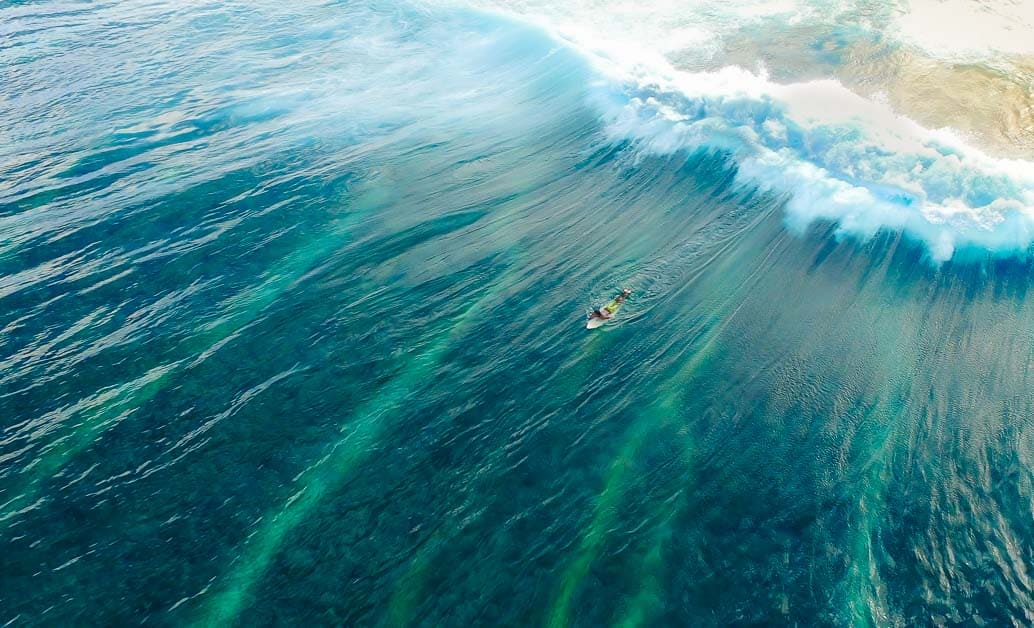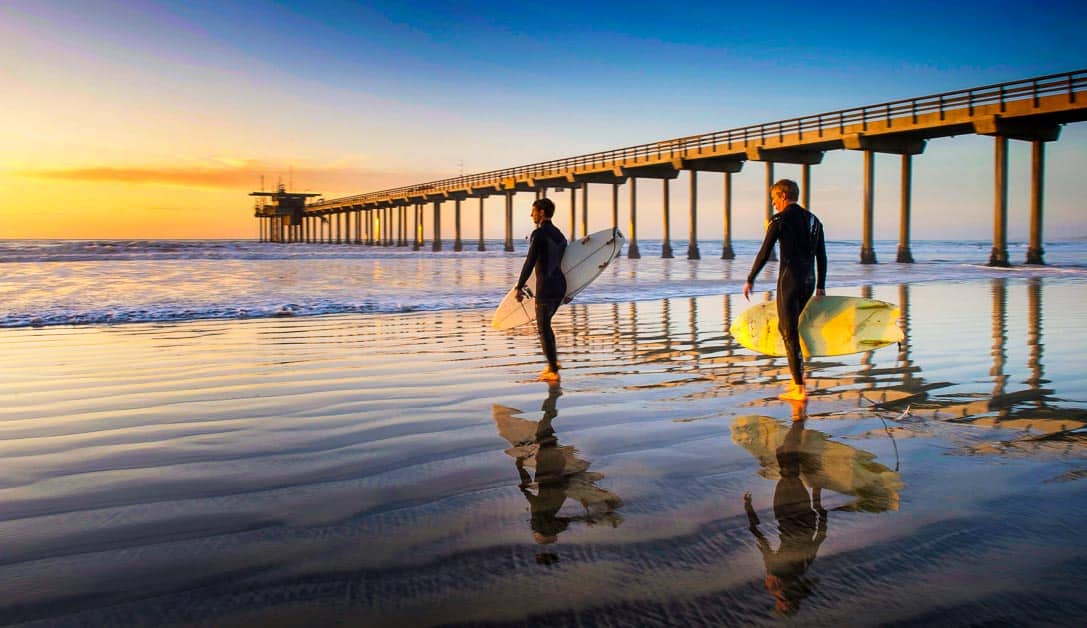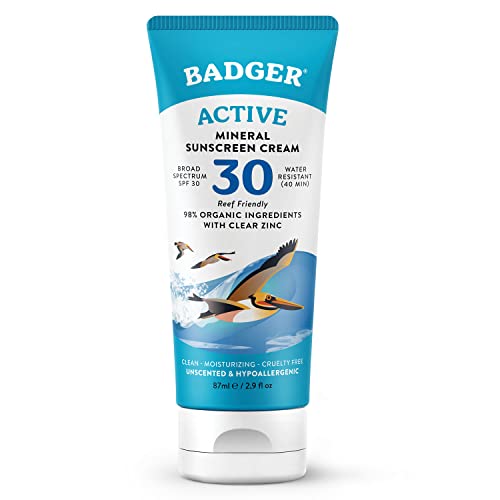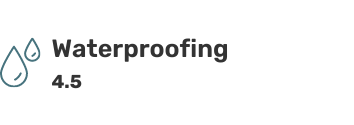It’s all too easy to forget about the sun when you’re surfing. The wind and water keep you cool and you’re also into catching waves. But a good sunscreen is essential to avoid damage from harmful UV rays. With a huge variety of products available it’s hard to choose a sunscreen. Here’s a list with reviews of the ten best sunscreens for surfing. You will find information on sun protection, water resistance, safety and how environmentally friendly the products are. Our Buyer’s Guide explains what to look for when choosing your sunscreen. And you’ll find the answers to some of the most frequently asked questions about the best sunscreen for surfing.
BEST SUNSCREEN FOR SURFING IN 2023
- BLUE LIZARD Reef-Safe Sunscreen
- SUN BUM Original SPF 50 Clear Zinc
- BADGER Broad Spectrum SPF 30
- THINKSPORT Safe Sunscreen SPF 50+
- SUN BUM Mineral SPF 50 Sunscreen
- ALL GOOD Organic Sunscreen Butter
- WAXHEAD Zinc Oxide Sunscreen Stick
- KOKUA Sun Care Hawaiian Natural Zinc Sunscreen
- BABO BOTANICALS Sheer Zinc Continuous Spray Sunscreen
- MANDA Organic Sun Paste
ALL THE SUNSCREEN FOR SURFING THAT WE TESTED
BLUE LIZARD Reef-Safe Sunscreen
General Impression
Free from Oxybenzone or Octinoxate, this reef-safe sunscreen is one of the best sunscreens for surfing on the market. It contains SPF 30+, which means keeping your skin safe from harmful UVA and UVB rays and has been recommended by dermatologists for offering true broad-spectrum protection. This surfer sunscreen is water-resistant for up to 80 minutes, meaning you can stay out in the water for longer before you have to reapply. It might be more expensive than some options on the market but ultimately offers value for money due to the overall effectiveness of the product. Therefore our top rated best sunscreen for surfing.
Specifications
SPF: 30
WEIGHT: 4.5 oz
WATER RESISTANCE: Up to 80 minutes
SAFETY: Designed for sensitive skin and fragrance-free
ENVIRONMENT: Reef safe, non-toxic formula
PROS
- No chemical-active ingredients
- Paraben and fragrance-free for sensitive skin
- Water-resistant for up to 80 minutes
- Dermatologist-recommended
- Easy to rub in
CONS
- More expensive than some surfing sunblocks
SUN BUM Original SPF 50 Clear Zinc
General Impression
Sun Bum is known to deliver quality and high-performing skin-care products. Its signature “summery” smell is part of the Original Clear Zinc sunscreen cream suitable for surfing and watersports.
Perfectly safe for those with sensitive skin, Sun Bum’s SPF 50 sunscreen cream is a great, broad-spectrum shield with a UVA/UVB filter and vitamin E. It’s recommended to apply a generous layer of the cream before going surfing or sunbathing – everything from your lips to your toes will be well-protected. Among our top rated best sunscreen for surfing.
Specifications
SPF: 50
WEIGHT: 1 fl oz
WATER RESISTANCE: Up to 80 minutes
SAFETY: For sensitive skin, all skin types
ENVIRONMENT: Recycleable; Cruelty-free; Vegan; Reef-friendly
PROS
- High SPF protection
- Quality ingredients
- Zinc oxide formula
CONS
- Reapplication is needed
BADGER Broad Spectrum SPF 30
General Impression
Containing 98% certified organic ingredients, this broad-spectrum surfers sunscreen from Badger receives rave reviews for blending naturally into a range of different skin tones (no ghost-like appearances here!) It’s fragrance-free and hypoallergenic for those with sensitive skin and gently moisturizes your face while offering SPF 30+ protection. The only downside to this reef-safe sunscreen is that one would need to reapply every 40 minutes if you’re out in the water. This product will always feature on the best sunscreen for surfing reviews!
Specifications
SPF: 30
WEIGHT: 2.9 oz
WATER RESISTANCE: Up to 40 minutes
SAFETY: Hypoallergenic
ENVIRONMENT: Reef safe, cruelty-free
PROS
- Doesn’t leave a white film on the skin
- Hypoallergenic for sensitive skins
- 98% organic ingredients
- Blends into your natural skin tone
- Reef safe and biodegradable
- Relatively affordable
CONS
- Works best if applied over a moisturizer
- Low water resistance compared to other sunscreens
THINKSPORT Safe Sunscreen SPF 50+
General Impression
This high factor SPF 50+ sunscreen has won an array of awards and is considered one of the best sunscreens for watersports on the market. It provides full UVA and UVB broad-spectrum coverage for up to 80 minutes before needing to be reapplied and is also relatively affordable. This product is free of biologically harmful chemicals, such as avobenzone and oxybenzone and absorbs rapidly into your skin, without leaving any greasiness. Unlike some sunscreens, there’s also no obvious smell, which makes it great as an everyday-wear sunscreen, no matter what you’re doing. This product will always feature on the best sunscreen for surfing reviews!
Specifications
SPF: 50
WEIGHT: 3 oz
WATER RESISTANCE: Up to 80 minutes
SAFETY: Free of biologically harmful chemicals, vegan
ENVIRONMENT: Reef safe and cruelty-free
PROS
- Vegan and gluten-free
- No oily residue
- Free of harmful chemicals
- Reef-safe
- High factor SPF 50+ protection
CONS
- Contains Epsom salt that can irritate some skins
- Takes time to rub in
SUN BUM Mineral SPF 50 Sunscreen
General Impression
Approved and recommended by the Skin Cancer Foundation, this SPF 50+ sunscreen is a natural, zinc-based product that’s completely chemical-free. It has a matte finish that blocks out the sun’s harmful rays while being hypoallergenic for those with sensitive skin. It’s designed to be suitable for children (so you only need to buy one sunscreen for the entire family) and will keep you protected in the water for up to 80 minutes before needing to be reapplied.
Specifications
SPF: 50
WEIGHT: 4.5 oz
WATER RESISTANCE: Up to 80 minutes
SAFETY: Hypoallergenic, ideal for sensitive skin, vegan and gluten-free
ENVIRONMENT: Cruelty-free
PROS
- Long-lasting for up to 80 minutes
- Broad-spectrum SPF 50+ protection
- Goes on matte for an oil-free finish
- Suitable for children
- Vegan-friendly and cruelty-free
CONS
- Takes time to rub in
- Relatively expensive
ALL GOOD Organic Sunscreen Butter
General Impression
Created using just six ingredients (including coconut oil, beeswax, and calendula flower-infused jojoba oil) – this high-end water-resistant sunscreen is one of the best face sunscreens for surfing. It’s ideal for protecting your face, nose, and ears while out in the water. It comes in a tin that can easily be slipped into your pocket or surf bag. Although costly, compared to other alternatives – that’s the price you pay for using one of the Environmental Working Group’s top-rated sunscreens on the market. It goes on white but rapidly rubs in for a clear finish and only needs to be reapplied every 80 minutes so you can spend more time out in the surf.
Specifications
SPF: 50
WEIGHT: 1 oz
WATER RESISTANCE: Up to 80 minutes
SAFETY: Oxbenzone, GMO and gluten-free
ENVIRONMENT: Reef safe, NSF-certified organic
PROS
- Oxybenzone and GMO-free
- Biodegradable and reef-friendly
- Long-lasting for up to 80 minutes
- Convenient tin packaging
- Organic ingredients
CONS
- Expensive
- Not ideal for full-body application
WAXHEAD Zinc Oxide Sunscreen Stick
General Impression
Sold as a large stick for easy application, this reef-safe sunscreen from Waxhead contains only certified organic and mineral ingredients. You don’t have to use a lot to get a solid coverage and it will keep you protected for up to 80 minutes in the water between applications. It’s designed so that it won’t run or sting your eyes, with a non-greasy and moisturizing formula. Deservedly popular with surfers and lifeguards, it can be applied to the face, nose, and ears, as well as those often-overlooked lips. The only complaint in surf sunscreen reviews is that it’s not ideal in hot weather when it melts and can become a mess to apply.
Specifications
SPF: 30
WEIGHT: 3.7 oz
WATER RESISTANCE: Up to 80 minutes
SAFETY: Hypoallergenic, made for sensitive skin
ENVIRONMENT: Reef safe, biodegradable
PROS
- Certified organic
- Large stick for easy application
- Water-resistant for up to 80 minutes
- Reef-safe and biodegradable
- Natural vanilla scent
CONS
- Takes time to rub in
- Relatively expensive compared to other sunscreens
- Not ideal in hot weather when it melts
KOKUA Sun Care Hawaiian Natural Zinc Sunscreen
General Impression
This Hawaiian-created sunscreen goes on like a moisturizing lotion and (unlike some water-resistant sunscreens) is light enough for everyday use. It’s made using 23 antioxidants to nourish the skin while you’re busy enjoying the great outdoors. Adding to its reputation as one of the best waterproof sunscreens for surfing is its successful use by those with eczema, melasma, and psoriasis, as well as being hypoallergenic for people with sensitive skin. It has a dedicated following of users due to its appealing non-greasy finish and superior water resistance, as well as staying put during heavy sweating.
Specifications
SPF: 50
WEIGHT: 3 oz
WATER RESISTANCE: Up to 80 minutes
SAFETY: Fine for facial usage, hypoallergenic, gluten-free
ENVIRONMENT: Reef safe, non-toxic formula
PROS
- Made with natural Hawaiian-grown ingredients
- Reef-safe and meets stringent international standards
- Top-rated by the Environmental Working Group
- Designed for sensitive skin
- Contains antioxidants to nourish the skin
- Ideal for the entire family
CONS
- Relatively expensive compared to other sunscreens
- Appears slightly white on some skin tones
BABO BOTANICALS Sheer Zinc Continuous Spray Sunscreen
General Impression
If you’re after a spray-on surf sunblock, this SPF 30+ option from Babo Botanicals is ideal. It’s lightweight and fast-absorbing, making application a breeze and is sensitive enough to be applied to babies and kids. When it comes to its environmental stats, it’s reef-safe and has been highly rated by the Environmental Working Group, as well as being gluten, dairy, soy, and peanut-free. It will keep you protected for up to 80 minutes either in the water or performing sweat-inducing activities. The only trick? Make sure you shake the can before application!
Specifications
SPF: 30
WEIGHT: 6 oz
WATER RESISTANCE: Up to 80 minutes
SAFETY: Fine for facial usage, hypoallergenic
ENVIRONMENT: Reef safe, non-toxic formula
PROS
- Spray-on application
- Reef-safe and mineral-based
- Chemical-free
- Water-resistance for up to 80 minutes
- Safe for babies and the entire family
CONS
- Only SPF 30 protection
- Need to shake before application for effective coverage
MANDA Organic Sun Paste
General Impression
While it might be expensive, this high-performance water-resistant sunscreen will stay on, even in the roughest elements. It’s been specifically designed for surfers, athletes, and adventurers who love being in the great outdoors while being made using all-natural and organic ingredients. Of particular note is its use of Thanaka, a naturally-derived product that’s been used for thousands of years by the Burmese people to protect their skin against the sun. It’s high in anti-oxidants, anti-bacterial and anti-fungal, and features an eco-friendly packaging made from bamboo and tin that can be repurposed or recycled.
Specifications
SPF: 50
WEIGHT: 1.4 oz
WATER RESISTANCE: N/A
SAFETY: Fine for facial usage, organic ingredients
ENVIRONMENT: Reef safe, non-toxic formula
PROS
- Contains thanaka
- Long-lasting water-resistance
- Chemical-free
- Can be applied thick or light
CONS
- Relatively expensive compared to other sunscreens
- Small product size
BEST SUNSCREENS FOR SURFING AND WATERSPORTS
Buyer's Guide
When you’re out in the water for long periods of surfing or participating in other water sports, it’s easy to forget that your skin is being exposed to the harmful rays of the sun. The water has a cooling quality that can be quite deceptive while your skin might actually be burning quite severely.
Investing in the best sunscreen for watersports is essential to protect your skin, whether you’re kayaking along the coast of Guatemala or beach hopping in Trinidad and Tobago. But with so many options on the market, it can be difficult to know what’s right for you. From zinc-based sunscreens to all-organic options, there is a myriad of options to select from. In this guide, we’ll explain some of the terminologies when it comes to buying the best waterproof sunscreen for surfing so you can make an informed purchase.
SPF
SPF stands for Sun Protection Factor and is a measure of the sunscreen’s ability to protect the skin from ultraviolet radiation (both long-wave UVA rays and short-wave UVB rays). UVB rays burn the top layer of the skin and contribute to cancer development while UVA penetrates the thick dermis, leading to long-term physical effects, such as wrinkling of the skin. A higher SPF number means your skin will be better protected from these harmful rays while “broad spectrum” means you will be protected against both types of ultraviolet radiation.
While remembering that no sunscreen will block all ultraviolet rays, it’s important to choose the best sunscreen for watersports with a high SPF rating. SPF 30+ sunscreens will filter out around 97% of incoming rays while SPF 50+ will keep out 98%. The difference might seem small but can have a big impact on those who are sensitive to sun damage or have a family history of skin cancer.
Water-Resistance
No sunscreen is completely waterproof but they all have a water-resistance rating that determines how long you can be out in the sun before needing to reapply the product. Most water-resistant sunscreens can be used for up to 40 or 80 minutes in the water, after which time their SPF protection starts to decline. If you’re heading out to surf or participate in water sports, then consider investing in the best waterproof sunscreen for surfing that you can afford. Look for a surfer sunscreen with water resistance for up to 80 minutes, just in case the conditions are so good that you don’t want to come back to shore.
Price
More expensive doesn’t always equate to better performing when it comes to the best sunblock for surfing and the price of products is influenced by several factors. The type of ingredients used, the packaging and the testing it has undergone – will all play a role in the price and the protective qualities the product has on offer.
If you’re looking for all-organic ingredients, then you’ll probably need to pay a little more. At the same time, the best sunscreen for surfers with multiple awards might result in a higher asking price. While you can get high-performing sunscreens that are relatively affordable, steer clear of anything that’s ultra-cheap as it’s probably too good to be true. At the end of the day – the amount you’re willing to spend on your sunscreen will be directly determined by the factors that are important to your well-being as a consumer.
Scent or fragrance-free
Whether you want a pleasant scent or a fragrance-free sunscreen is a highly personal decision. But if you have sensitive skin, you’ll probably want to opt for the latter, as “fragrance” often equates to some kind of chemical addition. This is not always the case, however, with some natural ingredients offering a subtle scent that can be appealing.
Thickness
The best sunscreen for water sports can be ultra-thick (more like a paste) or may be thin enough to apply like a lotion. Most surfers and water sports enthusiasts prefer something thick that’s going to be long-lasting, as liquid-like options tend to have a lot of alcohol that will result in them easily washing off. Unless you’re specifically looking for a zinc-based sunscreen, you probably don’t want it to be so thick that it’s difficult to rub in and will leave you looking like a ghost.
How to apply sunscreen for watersports?
Sunscreens should be applied at least 15 to 30 minutes before sun exposure, which gives time for the ingredients to fully bind to your skin. You’ll then need to reapply regularly, depending on the water-resistance labeling on the product and the time spent out in the sun. Be sure to apply the sunscreen liberally over all exposed areas of your body, including the backs of your hands, your neck, and ears, as well as the tops of your feet. If you can’t reach somewhere (such as your back), don’t be shy about asking someone for help – otherwise you’ll pay the price later.
BEST SUNSCREENS FOR SURFING AND WATERSPORTS
FAQs
1. What is the difference between zinc sunscreen and ordinary sunscreen?
While ordinary sunscreens contain chemicals and work by absorbing the sun’s harmful rays, zinc-based sunscreens sit on top of your skin and physically block them. Zinc oxide is a naturally sourced mineral while ordinary sunscreens often contain a whole host of chemicals that may irritate those with sensitive skin. Some experts recommend zinc oxide-based sunscreen for those with skin issues, as they are less likely to cause allergic reactions.
Whether you’re using a chemical-based sunscreen or zinc-oxide option, it’s important that you are wearing at least an SPF 30+ and reapply it as recommended on the packaging. If you’re participating in water sports, then it’s also essential that you select a sunscreen product that is water-resistant, no matter whether it’s chemical or zinc-oxide based.
2. Which sunscreens contain zinc oxide?
Any sunscreen that has zinc oxide listed as the main ingredient will protect you against both UVA and UBA rays as it acts as a physical blocker. Both zinc oxide and titanium dioxide (found in some sunscreens) sit on top of the skin and form a barrier against the sun’s rays. As a result, they will protect your skin as soon as you put them on.
However, not all sunscreens that contain zinc oxide are completely mineral-based, with some blending a variety of mineral and chemical actives. You can check the product packaging when purchasing a sunscreen over the counter to check exactly what it contains or look for chemical-free options if you’re purchasing online. If you have particular skin allergies or sensitivities, it’s essential that you check the ingredients to avoid any nasty reactions. Take a look at this detailed review of natural mineral, zinc oxide sunscreens for more guidance. They took the time to test over 120 different sunscreens!
3. Why do surfers use zinc?
Many surfers use zinc as their preferred sunscreen as it acts as a reflector that sits on top of the skin and prevents harmful rays from penetrating the surface. On the other hand, chemical-based sunscreens soak into the skin and only absorb the UVA and UVB rays once they’ve already penetrated the skin’s top layer.
Zinc will generally protect your skin for a long time in between reapplications and it doesn’t easily wash off in water, even in the most vigorous waves. It’s for this reason that it’s used by a lot of surfers who prefer its durability, as they don’t have return to shore during their session to reapply the product.
That being said, not all surfers use zinc and some prefer a lotion-style of sunscreen that rubs in clear. Both types can offer similar water-resistance qualities of up to 80 minutes in between applications before their SPF starts losing effectiveness.
4. What is the best zinc for surfing?
The best zinc for one surfer might be different from another, depending on their individual preference. Babo Botanicals offers a sheer zinc-based sunscreen that easily rubs in while Waxheads creates a thicker option that’s specifically designed for surfers. The zinc that’s right for you will depend on your budget, thickness preference and any skin allergies, as well as how environmentally friendly you want the product to be. Some surfing zincs are made using all-organic ingredients while others may have chemical additions. If you’re purchasing online, you can browse zinc surf sunblock reviews to read the experiences of other users and decide whether it’s the best surf sunscreen for you.
5. What is the best face sunscreen for surfing?
The best sunscreen for surfing will depend on your individual preference, with a variety of options on the market. You can find thick, zinc-based sunscreens that leave a matte, white finish or thinner lotions that will completely rub into your face. Many surfers prefer to know they have a zinc-based product that is effectively blocking any harmful rays, rather than a chemical-based sunscreen that is just absorbing them. Zinc is also harder to wash off when duck-diving or during a wipeout, giving you peace of mind that you’ll be protected, even in the biggest surf.
Surfing sunscreen reviews offer a wealth of information from other users about their experience with a product and can be helpful in deciding on the best option for you. At the end of the day – the best face sunscreen will depend on how much you’re willing to pay and the beneficial qualities the product has to offer.
6. Why should I not use an SPF higher than 50?
Most experts will tell you that a sunscreen with an SPF higher than 50 isn’t worth buying, with some outright misleading. According to both the Environmental Working Group and the Skin Cancer Foundation, higher SPF products are only marginally better at shielding you from UVB rays and can sometimes make users feel like they can stay out in the sun for longer, which is not a good idea at all.
For example, an SPF 50 sunscreen blocks out around 98% of harmful rays while an SPF 100 might block out 99%. However, users are often misled into thinking they are getting double the protection and fail to reapply when necessary. If you see a sunscreen marked higher than SPF 50, be sure to consider other factors and avoid getting blind-sided by a marketing ploy.
7. How else can I protect myself from the sun while surfing?
Aside from using a broad-spectrum, high-SPF-rated sunscreen, you can also protect yourself while surfing by wearing a surf hat that’s designed specifically for the water. They feature a stiff front brim for clear vision and padded neoprene straps, as well as a safety loop that you can attach to the zipper of your wetsuit just in case it gets pulled off in a wave.
Another way to protect yourself is by wearing a wetsuit or rash vest. This will reduce the need to apply sunscreen on your torso. The one that’s right for you will depend largely on the conditions in which you’re surfing, with options ranging from thin 1mm rashies to thick 4/3mm wetsuits with inbuilt hoodies. If your zinc or sunscreen can’t be applied to the lips, you might also consider getting the best surf lip balm you can find so that you don’t end your session with burnt lips.


REACH OUT
For more beach activity items, check out our reviews on waterproof surf watches, bodyboarding leashes, paddle boards for beginners and tackle boxes for the fishing lovers.
As always, we create our content with you, fellow adventurers, in mind. So, how’d we do? Did you find this informative? Did it help you make a decision? Did we miss anything? We’d love to hear from you below. Thanks for reading and we hope your next adventure is a great one!





























